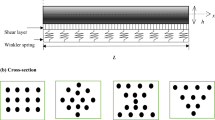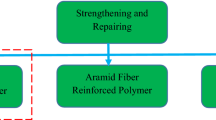Abstract
Ultrahigh toughness cementitious composites (UHTCC) obviously show strain hardening property under tensile or bending loading. The failure pattern of the UHTCC components exhibits multiple fine cracks under uniaxial tensile loading with prominent tensile strain capacity in excess of 3%, with merely 60 μm average crack width even corresponding to the ultimate tensile strain state. The approach adopted is based on the concept of functionally-graded concrete, where part of the concrete, which surrounds the main longitudinal reinforcement in a RC (reinforced concrete) member, is strategically replaced with UHTCC with excellent crack-controlling ability. Investigations on bending behavior of functionally-graded composite beam crack controlled by UHTCC has been carried out, including theoretical analysis, experimental research on long composite beams without web reinforcement, validation and comparison between experimental and theoretical results, and analysis on crack control. In addition to improving bearing capacity, the results indicate that functionally-graded composite beams using UHTCC has been found to be very effective in preventing corrosion-induced damage compared with RC beams. Therefore, durability and service life of the structure could be enhanced. This paper discusses the development of internal force and crack propagation during loading process, and presents analysis of the internal force in different stages, moment-curvature relationship from loading to damage and calculation of mid-span deflection and ductility index. In the end, the theoretical formulae have been validated by experimental results.
Similar content being viewed by others
References
Shen R X, Cui Q, Li Q H. New Type Fiber Reinforced Cement-based Composites (in Chinese). Beijing: China Building Material Industry Publishing House, 2004
Huang H T, Lang J F, Fu Z D. The process of the study of cement-based functionally gradient material (in Chinese). Shanxi Archit, 2007, 33(7): 168–169
Brichall J D, Howord A J, Kendall K. Flexural strength and porosity of cements. Nature, 1981 (289): 388–390
Young J F, Berg M. A novel organo-ceramic composite. Mater Res Soc, 1992(271): 609–619
Young J F. Advanced cement based materials. Proceedings of the 5th International Symposium on Cement and Concrete. Shanghai, 2002
Yoshio K. Physical properties of polymer-modified mortar. Polymers in Concrete. Proceedings of the 3rd International Congress on Polymer in Concrete, Fukushima, Japan, 1981
Smamy R N. Review polymer reinforcement of cement systems. Mater Sci, 1979, (14): 1521
Niino K, Toshio T H, Watanaber Y. Functionally gradient Material-Investigation on High Temperature Material of Aviation Arrangement. J Jpn Soc Compos Mater, 1978, 13(6): 257–264
Yang J J, Dong Y L. Effect of fiber gradient distribution on the concrete strength (in Chinese). Henan Sci, 2002, 20(6): 645–648
Zhu X H, Meng Z Y. Current research status and prospect of functionally gradient materials (in Chinese). J Funct Mater, 1998, 29(2): 121–127
Shon I J, Munir Z A. Synthesis of Tic, TiC-Cu composite, and TiC-Cu functionally graded materials by electro thermal combustin. J Am Ceram Soc, 1998, 81(12): 3243–3248
Capus J M, Advanced in powder metallurgy processing. Adv Mater Process, 1999, 156(3): 33–37
Zhang P W, Zhou Z G, Wu L Z. The non-local theory solution of a Griffith crack in functionally graded materials sabjected to the harmonic anti-plane shear waves. Sci China Ser E-Tech Sci, 2007, 50(2): 154–165
Yang J J, Jia X L, Tan W, etc. Preliminary study on physical and mechanical properties of cement-base gradient compound and functional material (in Chinese). New Build Mater, 2001, (11): 1–7
Maalej M, Li V C. Introduction of strain hardening engineered cementitious composites in design of reinforced concrete flexural members for improved durability. ACI Struct J, 1995, 92(2): 167–176
Li V C, Leung C K Y, Steady State and Multiple Cracking of Short Random Fiber Composites. ASCE J Eng Mech, 1992, 188(11): 2246–2264
Li V C. On Engineered Cementitious Composites (ECC)-A review of the material and its applications. J Adv Concr Technol, 2003, 1(3): 215–230
Li V C, Wang S, Wu C. Tensile strain-hardening behavior of PVA-ECC. ACI Mater J, 2001, 98(6): 483–492
Xu S L, Li H D. A review on development of researches and engineering applications of ultra high toughness cementitious composites. China Civ Eng J, 2008, 41(6): 72–87
Li V C et al. Matrix design for pseudo strain-hardening fiber reinforced cementitious composites. RILEM J Mater Struct, 1995, 28(183): 586–595
Wang T M. Control of Cracking in Engineering Structure (in Chinese). Beijing: China Architecture and Building Press, 1997
Maalej M, Ahmed S F U, Paramasivam P. Corrosion durability and structural response of functionally-graded concrete beams, J Adv Concr Technol, 2003, 1(3): 307–316
Cheng W R, Kang G Y, Yan D H. Principle on Concrete Structure Design (in Chinese). Beijing: China Architecture & Building Press, 2002
Xu S L. Research on ultrahigh toughness green ECC and its application (in Chinese). Dalian: Dalian University of Technology, 2007
Maalej M, Li V C. Flexural strength of fiber cementitious composites. ASCE J Mater Civ Engin, 1994, 6(3): 390–406
Li V C, Horikoshi T, Ogawa A et al. Micromechanics-based durability study of Polyvinyl Alcohol-Engineered Cementitious Composite (PVA-ECC). ACI Mater J, 2004, 101(3): 242–248
Li Z J. Elementary Reinforced Concrete Design (in Chinese). Beijing: Tsinghua University Press, 2005
Author information
Authors and Affiliations
Corresponding author
Additional information
Supported by the Key Program of the National Natural Science Foundation of China (Grant No. 50438010) and the Research and Application Programs of Key Technologies for Major Constructions in the South-North Water Transfer Project Construction in China (Grant No. JGZXJJ2006-13)
Rights and permissions
About this article
Cite this article
Xu, S., Li, Q. Theoretical analysis on bending behavior of functionally graded composite beam crack-controlled by ultrahigh toughness cementitious composites. Sci. China Ser. E-Technol. Sci. 52, 363–378 (2009). https://doi.org/10.1007/s11431-008-0337-9
Received:
Accepted:
Published:
Issue Date:
DOI: https://doi.org/10.1007/s11431-008-0337-9




